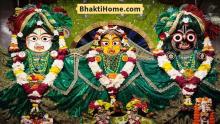
Jagannath Temple Facts
| Deity | Lord Jagannath (Lord Vishnu) |
| Location | Puri, Orissa |
| Darshan Timings | 05:30 AM - 10:00 PM |
| Darshan Break Timings | 08:00 AM - 09:15 AM |
| Entry Fee | Free |
| Best Time to Visit | October to February |
| Festivals | Rath Yatra |
| Dress Code | Any Decent outfit |
Jagannath Temple
The Jagannath Temple stands as one of India's highly esteemed religious sites, attracting hundreds of thousands of devotees annually.
It holds a distinguished place among the four Dhams (the holiest of holy places) in India, along with Dwarika, Badrinath, and Rameswaram.
Within its sacred walls in Puri, Odisha, Lord Krishna is venerated in His form as Lord Jagannath. Alongside Him reside His elder brother, Lord Balbhadra, and His younger sister, Goddess Subhadra.
Lord Jagannath
Lord Jagannatha is also commonly referred to as Mahaprabhu, where "Maha" signifies greatness, and "Prabhu" represents Lord. Jagat means Universe & Natha means Lord. Lord Jagannatha name indicates "Lord of Universe" or "Ruler of the Universe".
Within the sacred texts of Sanatana Vaidika Dharma, He is also identified as Purushottama, denoting The Supreme Divine Being.
The splendor of Lord Jagannatha finds extensive mention in countless scriptures, spanning from the Vedas, humanity's earliest scriptures, to the Puranas, as well as subsequent literary compositions in both Sanskrit and Odia languages.
These scriptures firmly establish Lord Jagannatha as the One Omnipotent, Omnipresent, and Omniscient Supreme Deity. He is referred to as Paramatma, signifying the Supreme Self, Parameshwara, indicating the Supreme Lord, and Param-Brahman, representing the Supreme Omnipresent Deity, within the texts of Sanatana Vaidika Dharma.
Lord Jagannatha is invoked in numerous names and forms across diverse religious traditions and beliefs worldwide.
The philosophy and tradition surrounding Lord Shree Jagannatha ardently promote the fundamental principles of Hinduism, encapsulated in the concepts of "Ekam Sat Viprah Bahudha Vadanti," which underscores that there is only one ultimate truth, expressed diversely by the enlightened, and "Vasudhaiva kutumbakam," emphasizing that the entire humanity constitutes the family of the One God.
Jagannath Temple mysteries
Numerous unexplained phenomena, mysteries, and inexplicable events are associated with this temple, and they defy scientific explanation. For years, historians, scientists, priests, and ordinary individuals have made persistent efforts to unravel these enigmas, but they continue to baffle us, shrouded in mystery to this day.
Mysterious Chakra Direction
Atop the temple, a colossal wheel of fortune or chakra weighing around a ton is positioned. Remarkably, regardless of where one views it from within Puri, the chakra consistently appears to face inward, a perplexing achievement for the 12th-century builders.
Other than this, The Sudarshan Chakra, positioned at the apex of the temple, is crafted from a substantial amount of metal, weighing in at more than 1000 kilograms! It remains a mystery as to how such a heavy object was raised to that height during an era devoid of electricity or advanced technology.
Flag's Unique Direction
At the pinnacle of the Jagannath Temple, an intriguing tradition unfolds as the temple's flag flutters against the prevailing wind direction. This ancient custom, dating back 1800 years, involves a priest ascending the Shikhara daily to change the flag. Legend has it that a single missed ritual would result in the temple's closure for a daunting 18 years. This awe-inspiring structure reaches the height of a 45-story building, and the flag-changing ritual is performed without any protective gear, relying solely on bare hands.
Absence of Shadow
Remarkably, the Jagannath Temple does not cast a shadow, regardless of the time of day or the sun's position in the sky, leaving observers puzzled about whether this phenomenon is a architectural marvel or a divine miracle.
Silence of the Sea
Upon entering the temple, the roaring sound of the sea suddenly disappears. Legend suggests that Goddess Subhadra desired a serene temple environment, and to honor her wish, the temple silences the sea's tumultuous sound.
Reverse Sea Breeze
In coastal areas, it's customary for the sea breeze to blow towards the land during the day and reverse towards the sea in the evening. However, in Puri, this natural phenomenon unfolds in the opposite manner, adding to the mystique of the region.
No Flying Above Temple
Unusually, no birds or aircraft are seen hovering above the temple dome, confounding any logical explanation for this phenomenon.
Wooden Idols and Nabakalebara
The temple's sacred wooden idols undergo a transformative process known as Nabakalebara every 8, 12, or 19 years, where new idols replace the old ones. Neem trees meeting specific criteria are carefully chosen for this purpose. Skilled carpenters carry out the intricate carving in secrecy over a span of 21 days. The retired idols find their final resting place near Koili Vaikuntha. The most recent Nabakalebara occurred in 2015, witnessed by millions of devotees.
Abadha Mahaprasadam
The Mahaprasad offered to Lord Jagannath consists of 56 delectable dishes, served in 5 phases. It comes in two varieties, sukhila (dry confectioneries) and shankhudi (including rice, dal, and other items). Devotees can savor this divine cuisine at Ananda Bazaar, a market within the temple premises.
Mahaprasadam Preparation
Thousands of priests collaborate to prepare the Mahaprasadam, which involves stacking seven earthen pots on top of one another and cooking the food over firewood. Surprisingly, the topmost pot cooks first, a culinary enigma.
Prasadam Abundance
Despite the fluctuating number of pilgrims, the temple consistently prepares the same quantity of food (Jagannath Prasadam) daily, ensuring that no food goes to waste, and every devotee receives nourishment.
Best Time To Visit
☀️Summer (March to May, June)
With a generally pleasant climate year-round, Jagannath Puri attracts visitors throughout the year, except during the peak summer months of April to June.
Summer in Puri can be quite challenging to endure. The coastal city experiences a high level of humidity and scorching heat during this season, creating uncomfortable conditions for travelers.
While exploring the various attractions in Puri can be challenging during the summer months, spending time on the beach offers a refreshing respite. The cool waters of the beach provide relief to many travelers who come to enjoy Puri's coastline.
Summer temperatures in Puri can vary, ranging from a low of twenty degrees Celsius to a high of forty-five degrees Celsius. The weather is characterized by high humidity and hot conditions, resulting in warm days and nights.
⛈️Monsoon (July to September)
Individuals seeking divine blessings can plan their visit to this location during the Rath Yatra, which typically takes place between June and July. From June to September, Puri encounters frequent thunderstorms and consistent heavy rainfall. During the monsoon months, the temperatures typically remain in the range of twenty-seven to thirty-one degrees Celsius. Heavy rains are a common occurrence during this period.
If you plan to witness the vibrant Rath Yatra festival during these months, it's advisable to make advance reservations for accommodations, as places to stay tend to be heavily crowded with visitors during this season.
❄️Winter (October to February)
The best time for a visit to Puri is during the months from October to February when you can enjoy pleasant weather without the discomfort of scorching heat or excessive humidity. Although winters (December to February) bring cooler temperatures, they are still ideal for beach activities and temple visits.
official websites https://shreejagannatha.in and https://stayatpurijagannatha.in
How To Reach
Puri serves as a prominent railway hub (Puri Junction) with excellent connectivity to major cities across the country. The nearest airport (Biju Patnaik International Airport - BBI ) is located in the capital city, Bhubaneshwar, which is approximately 59 kilometers away from Puri. You can easily hire a taxi from the airport to reach Puri.
✈️ By Air
The closest airport to Puri is Biju Patnaik International Airport (Airport Code - BBI) in Bhubaneswar, located approximately 59 km from the center of Puri. This airport offers connections to major cities like Delhi and Mumbai. International travelers usually need to make connections through Delhi or Kolkata when flying to Puri.
🚝 By Train
Puri serves as a significant railway hub with regular direct train services connecting it to various cities across India, including Bhubaneswar, New Delhi, Chennai, and Kolkata. Puri railway station is the nearest station with code - PURI.
🚗 By Road
Puri is well-connected to its neighboring cities via a network of well-maintained roads. Buses are the primary mode of transportation to reach Puri, with the bus stand located in close proximity to the Gundicha Temple. You can reach Bhubaneshwar and Cuttack within 15 minutes by bus.
Jagannath Temple Darshan / Opening Timings
Visiting the Jagannath Temple for darshan of Shree Jagannatha Mahaprabhu is possible throughout the day, except during certain festive occasions.
The temple typically opens for darshan at around 5:30 A.M.
Devotees can enter up to the Jagamohan (Bhitar Kaatha) of the temple and have darshan from this point until the completion of the "Besha," which is usually around 7:30 or 8 A.M.
There is a break in darshan for about 1 hour and 15 minutes after the completion of the Besha (approximately from 8 A.M. to 9:15 A.M.) for the performance of Gopal Ballava Puja.
After the Gopal Ballava Puja, devotees can have darshan from the 'Naatamandir' (Baahaar Kaatha) until the completion of the 'Sakaala Dhoopa Puja' (approximately up to 11 A.M.).
Following the Sakaal Dhoopa, entry is allowed up to the Jagamohan until the completion of the "Bhoga Mandap Puja" (approximately up to 1 P.M.).
Darshan from near Bhitar Kaath / Jagamohan is also available between 2 P.M. to 5:30 P.M., which includes the period from the completion of Madhyanha Dhoop to the completion of Sandhya Aalati, as well as from the completion of Sandhya Dhoopa to the completion of the Chandan Laagi ritual (approximately from 8 P.M. to 9 P.M.).
What to do for Smooth Darshan?
To ensure a smooth darshan experience for devotees and crowd control, barricades have been set up at the Lion's Gate / Eastern Gate (the main entrance of the Temple) and at 'Kirtan Chakadaa' (the inner courtyard) for the orderly movement of devotees in queues.
Entry and Exit Points:
The 'Lions gate' is the sole entry point for entering the temple, while the other three gates are used for exit purposes for devotees. Officials, sevaks, and residents of Puri town can enter through any gate with proper ID proof.
Question: Which divine beings are venerated at the Jagannatha Temple in Puri?
Answer: The main 3 Gods/Goddess are - Lord Jagannatha (the younger brother), Lord Balabhadra (the elder brother), Lord Subhadra (the sister)
Question: What are the names of the three chariots belonging to the three deities?
Answer: Lord Jagannatha's chariot is called Nandighosa. Lord Balabhadra's chariot is known as Taladhwaja. Goddess Subhadra's chariot is named Darpadalana.
Question: Are individuals of all faiths permitted to enter the temple?
Answer: No, only Hindus are granted entry into the temple.
Question: Is there a charge for admission to the Jagannath temple?
Answer: No, there is no admission fee at the Jagannath temple. Devotees can visit and have a glimpse of Lord Jagannath without any cost.
Question: Where can one find accommodations near Jagannath Temple in Puri?
Answer: There are numerous hotels located near Jagannath Temple where you can choose to stay. These hotels offer a range of options, from budget-friendly to luxurious rooms. Additionally, the Jagannath Temple Administration provides two guest houses for pilgrims: Shri Gundicha Bhakta Niwas and Nilachal Bhakta Yatri Nivas. You can make online reservations for rooms by visiting their website.
Question: What are the ideal months for a visit to the Jagannath temple in Puri?
Answer: Puri is open for visits year-round, but certain months are typically favored due to the religious events that occur during them. The best time to visit Puri is from October to March. During this period, the weather is cooler, making sightseeing very enjoyable.
Question: When is the Puri Rath Yatra scheduled for?
Answer: The Ratha Yatra for this year is scheduled to take place in July.

